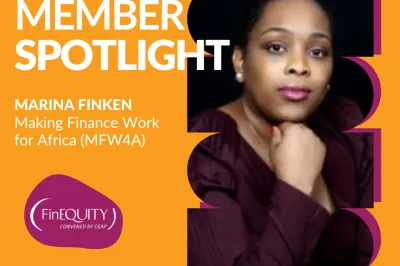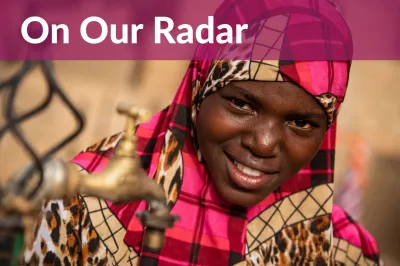How Can Financial Inclusion Tackle the Drivers of Gender Inequality and Reduce Women’s Vulnerability to Climate Change?

Women in developing countries are among the hardest hit by climate change. They are often disproportionately responsible for the majority of household chores, from fetching water to cooking and caring for their families. Climate change exacerbates these already challenging tasks as droughts and water scarcity make it difficult for women to access the resources they need. Floods, hurricanes, and other extreme weather events cause further challenges as they damage homes and disrupt livelihoods. Women are thus forced to spend even more time and resources trying to secure basic necessities – leaving less time for income-generating activities.
Finance can be a tool to address these inequalities that take root at the nexus of gender and climate change. However, the same gender norms that shape inequality and result in women being more vulnerable to the impacts of a changing climate, also limit women's financial inclusion and economic empowerment. Understanding and addressing these drivers of inequality is therefore a critical step in leveraging financial inclusion as a tool for both women’s economic empowerment and a just climate transition.
At the FinEquity 2023 Annual Meeting, one of the member-led sessions focused on how stakeholders working in the financial inclusion space can better understand the financial needs of women that are shaped by gender norms, and how they can then design solutions that integrate the behavior changes needed to accelerate adoption and use of financial services that address climate challenges and women’s economic empowerment.
The same gender norms that shape inequality and result in women being more vulnerable to the impacts of a changing climate, also limit women's financial inclusion and economic empowerment.
Understanding women’s unique lives and contexts
For financial institutions to design products and services that enable women to build resilience to climate change or to adapt their livelihoods, it is important to recognize that women’s financial needs, preferences, and capacities are different from those of men. This is often a result of gender norms and gendered roles within the household. However, conducting this type of detailed data collection about women’s lives and the constraints they face can be costly and time consuming.
During the session, Dr. Natalia Realpe Carrillo from Hedera Sustainable Solutions shared how they use digital surveys and work with microfinance institutions (MFIs) and impact investors to provide tools for in-depth customer needs assessments, financial product design, and impact data management. Hedera has worked with institutions across Latin America, Sub-Saharan Africa, and South Asia to interview over 10,000 households and micro, small and medium-sized enterprises (MSMEs). By understanding how climate shocks are impacting women’s daily lives, the MFIs were able to identify opportunities for financing solutions such as improved cook stoves, water access, and electrification. These solutions not only saved women time, but also offered benefits to the wellbeing of their households. By empowering loan officers and branch managers to collect and analyze data regularly, MFIs can further understand the evolving challenges their women clients face and identify local solutions.
By understanding how climate shocks are impacting women’s daily lives, the MFIs were able to identify opportunities for financing solutions such as improved cook stoves, water access, and electrification.
Financing technologies for women’s climate needs
Enabling access to clean energy solutions, such as off-grid solar products, can alleviate some of the challenges faced by low-income women, while at the same time supporting a green energy transition, catalyzing economic growth, and reducing overall poverty. Lukas Kellar from GIZ shared their Digital Green Inclusive Finance (DGIF) Framework that combines digital, green, and inclusive components to enable a just transition towards net zero and pursue a feminist development policy. Offering an example of this framework in action, GOGLA’s Rebecca Rhodes explained how pay-as-you-go (PAYGO) off-grid energy products and services can contribute to a more just and inclusive future. Clean and reliable lighting extends productive hours and gives women the ability to power mobile phones, radios, and televisions – unlocking access to information, education, and financial tools. Access to efficient solar-powered fans is becoming a vital tool in building resilience to climate-affected temperatures and avoiding heat stress. And in agricultural value chains, where women occupy most post-harvest roles, access to refrigerators can have a significant impact on reducing food loss and increasing incomes.
However, the current range of PAYGO products and solutions are not necessarily easily accessible and available to women for a number of reasons, including a lack of knowledge and awareness about their potential benefits. To ensure these technologies are affordable and reach their target market, there is a need to ensure a gender lens in the design and marketing of both the technologies and their financing.
To ensure these technologies are affordable and reach their target market, there is a need to ensure a gender lens in the design and marketing of both the technologies and their financing.
Leveraging edutainment for behavior change
Edutainment is another powerful tool for enabling tangible changes in knowledge, attitudes, and practices that can support gender equality and reduce women’s climate vulnerability. Emma Etchells of the Mediae Company detailed how they are using edutainment through their flagship television program "Shamba Shape Up". The reality makeover program showcases in-depth agricultural information for rural and urban farmers. The show reached around 8 million viewers in 2022, with a primary target audience of youth and women. In partnership with the Kenya Women Microfinance Bank (KWFT), they included 12 modules on financial literacy in the show on topics such as savings, credit, and managing farm finances. iShamba, a mobile phone based digital support service, enables viewers to interact with the show, speak with trained agronomists, and receive weekly agricultural tips, weather forecasts, and market prices – supporting their resilience to climate-related shocks and changes. Targeted messages to women subscribers further increased their use of iShamba, with 35,000 women signing up for the paid service. Results from impact studies that measure changes in knowledge, attitudes, and practices showed significant positive impacts in the use of financial tools and practices among both male and female farmers.
An early example of using media to change practices in financial inclusion is Makutano Junction, a Kenyan soap opera that captured different themes affecting African society, such as corruption, financial education, early marriages, and conflict resolution. Women’s World Banking ran a parallel campaign called “Nwari Dada” alongside the show, encouraging underbanked women to open new bank accounts. By the end of the campaign, 138,000 women opened new accounts with three banks in Kenya.
Edutainment is another powerful tool for enabling tangible changes in knowledge, attitudes, and practices that can support gender equality and reduce women’s climate vulnerability.
Access to climate-smart solutions such as improved cook stoves, solar home systems, and off-grid productive-use appliances can reduce low-income women’s time poverty and increase productivity, while also supporting a green transition. Yet, in many developing countries, a lack of affordable financing options is a barrier to such technologies, particularly for women-led small businesses and households. The adoption and use of new technologies require changes in behavior by both the customer, who may not see the benefits, as well as by those designing the technologies and financing them, as they may not recognize the specific challenges and needs of women as customers. To address these barriers, there is a need to start by better understanding the lives and contexts of women, facilitating financing for appropriate technologies, and leveraging tools such as edutainment to support behavior change.
A recording of this session can be found here.


